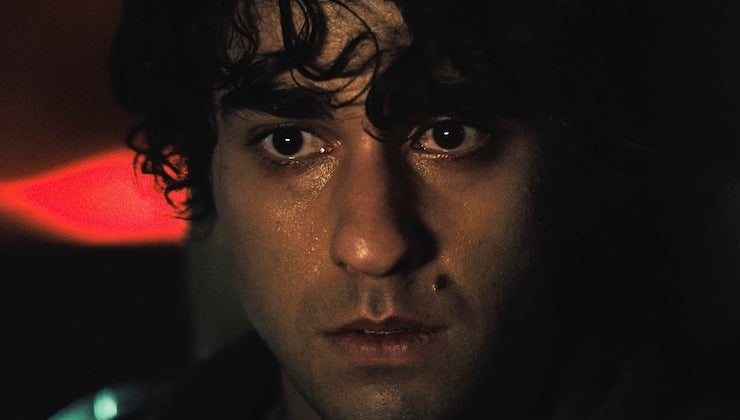sample heading
To celebrate the release of the second season of Come Join Us By The Fire, our audio horror anthology, we’ve asked authors with stories included in this year’s anthology to join us and write about horror. Below, Nibedita Sen, whose story “Pigeons” you can listen to here, writes about how, when it comes to horror, less is so often more.
There’s a scene in The Others (2001) that has stuck with me since I first saw it. A young brother and sister sit on their beds in a dark room at night, whisper-arguing about the existence of ghosts. The curtains are thick, heavy, and drawn tight; both siblings suffer from a rare kind of photosensitivity where daylight burns their skin.
The girl, the older of the two, insists their bedroom is haunted by the ghost of a little boy. Her frightened little brother accuses her of lying, says she’s trying to scare him. And then—it happens.
The curtains twitch. Something yanks them open at one end, and there—shaped against the sliver of revealed moonlight for the briefest of moments—is a silhouette.
The silhouette of a little boy.
A little goes a long way when it comes to writing horror. A disembodied touch on the shoulder can spook you more than a punch to the face. A snatch of movement in the corner of your eye can be as unnerving as a full jumpscare. Your mileage may vary, of course—our experience of fear is as subjective as it is deeply personal. Me? I love a good creature feature or slasher movie as much as the next person, but the horror that gets under my skin and nests there tends to be the kind that’s sparse and restrained. I fear the strange noises out past the campfire’s light more than I do the monster I can see close and clear enough to count its limbs and teeth.
It feels like a truism at this point to say that we fear the unknown, but here’s the thing: we do. Knowing we’re (literally or metaphorically) in the dark fills us with unease, and horror, as a genre, is all about expertly wielding that dread to make us dance to its tune. Lovecraft may have been a racist bigot, but there’s something to the idea of horror so vast it becomes incomprehensible. Fear that surpasses our capacity for language.

Hereditary (2018) has what I consider one of the most powerful horror moments of all time precisely because of what it doesn’t show. There’s a speeding car, a person sticking their window out the backseat window, and a decapitation—only we never actually see head part company with body. Just the wooden telegraph pole approaching at speed, and then a sickening thud offscreen as the camera cuts to the driver. Where it stays for the next few minutes as the car comes to a halt and the driver sits there, frozen—just trained on his unmoving, unblinking face, letting us absolutely baste in his horror as we, like him, slowly wrap our heads around what just happened and our imaginations run wild picturing what we can’t see.
Unfortunately, Hereditary is also a perfect example of a trap horror writers so often fall into—the trap, that is, of abandoning all restraint and going overboard at the very end. There’s value in catharsis after sustained tension, but that’s not what happens in the last ten minutes of Hereditary. Instead, we get death and self-mutilation, chanting cult members, naked, aged female bodies presented as grotesque, and, most importantly—an attempt to thoroughly explain the villains’ history and motives.
It’s easy to feel obligated to give your audience a payoff worth their time. It’s tempting to want to contextualize everything they’ve just seen. But not everything needs explanation, or is improved by it. It’s not for no reason that we talk about being ‘haunted’ by unfinished business and unanswered questions, after all. Sometimes the thing that wasn’t on the page is what we can’t stop thinking about—the omission terrifying by its very nature.
Sometimes, a reader’s imagination will do more to horrify itself, left to run rampant, than you could have done in its place.
Sometimes, less is more.
Of course, it’s equally possible to go too far in the opposite direction and leave things so vague, so incomplete, that your reader feels cheated and dissatisfied. Like all writing advice, this isn’t one size fits all, so let me be as clear as possible that “less is more” does not necessarily apply to explicitly calling out horrors like racism or bigotry. Silvia Moreno-Garcia’s brilliant Mexican Gothic is extremely explicit about the white supremacist, eugenicist motives of its villains, and the book wouldn’t have worked nearly as well as it did if she’d shrouded those motives in euphemisms and vagueness. Practicing restraint isn’t an invitation to elide the truth.
How, then, to walk the fine line between saying too much and too little?
Ask yourself what’s actually important to the story. Is it the exact nature of the monster—or just how your character reacts to it?
Ask yourself if the time is right. Will bringing the monster into the light ameliorate the tension you’ve created too soon—or is it possible that you want your reader to feel a moment of relief before you twist the screws again?
Ask yourself if those fascinating background details you came up with to better understand your story, and your characters, will actually enhance a reader’s enjoyment of the story. They might. But what if you left them unsaid? Let the reader’s imagination fill in the blanks?
Ask yourself what’s scarier to your reader or character. Seeing the act on the page—or hearing it happen out of sight, or stumbling on the aftermath, or piecing it together from what went unsaid?
And above all, remember—there’s a reason why we tell ghost stories around a campfire. There’s a delicious thrill to knowing the fire’s light only reaches so far—more delicious, sometimes, than knowing exactly what might be waiting in the dark.
Nibedita Sen is a Hugo, Nebula, and Astounding Award-nominated queer Bengali writer from Calcutta, and a graduate of Clarion West 2015 whose work has appeared or is forthcoming in Anathema: Spec from the Margins, Podcastle, Nightmare and Fireside. She accumulated a number of English degrees in India before deciding she wanted another in creative writing, and that she was going to move halfway across the world for it. These days, she can be found working as an editor in NYC while consuming large amounts of coffee and videogames. She helps edit Glittership, an LGBTQ SFF podcast, enjoys the company of puns and potatoes, and is nearly always hungry. Hit her up on Twitter at @her_nibsen, where she can usually be found yelling about food, anime, and what she’s currently reading.
Listen to Nibedita’s story “Pigeons” on Google Play here, and listen the the entirety of the second season of Come Join Us By The Fire here.



